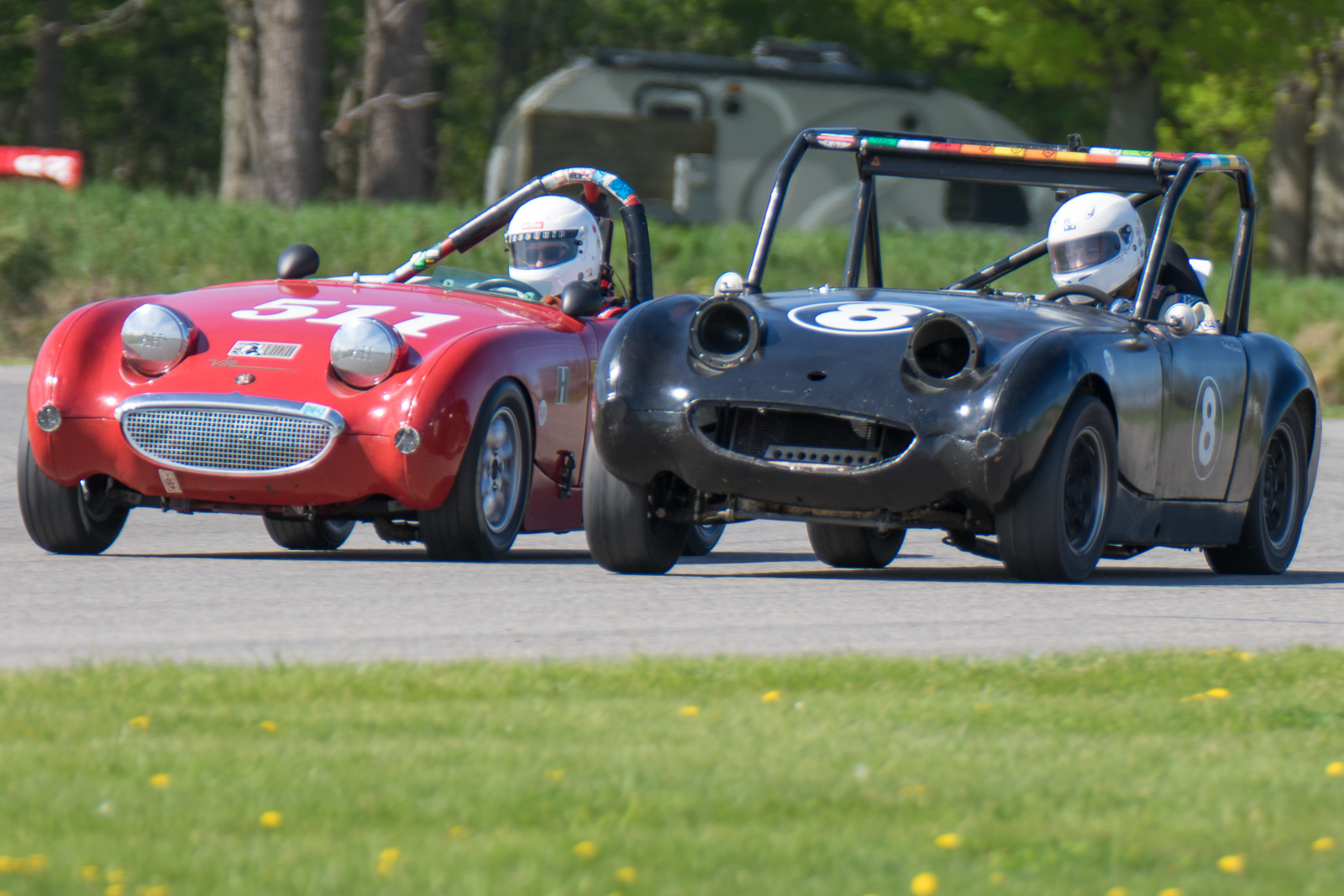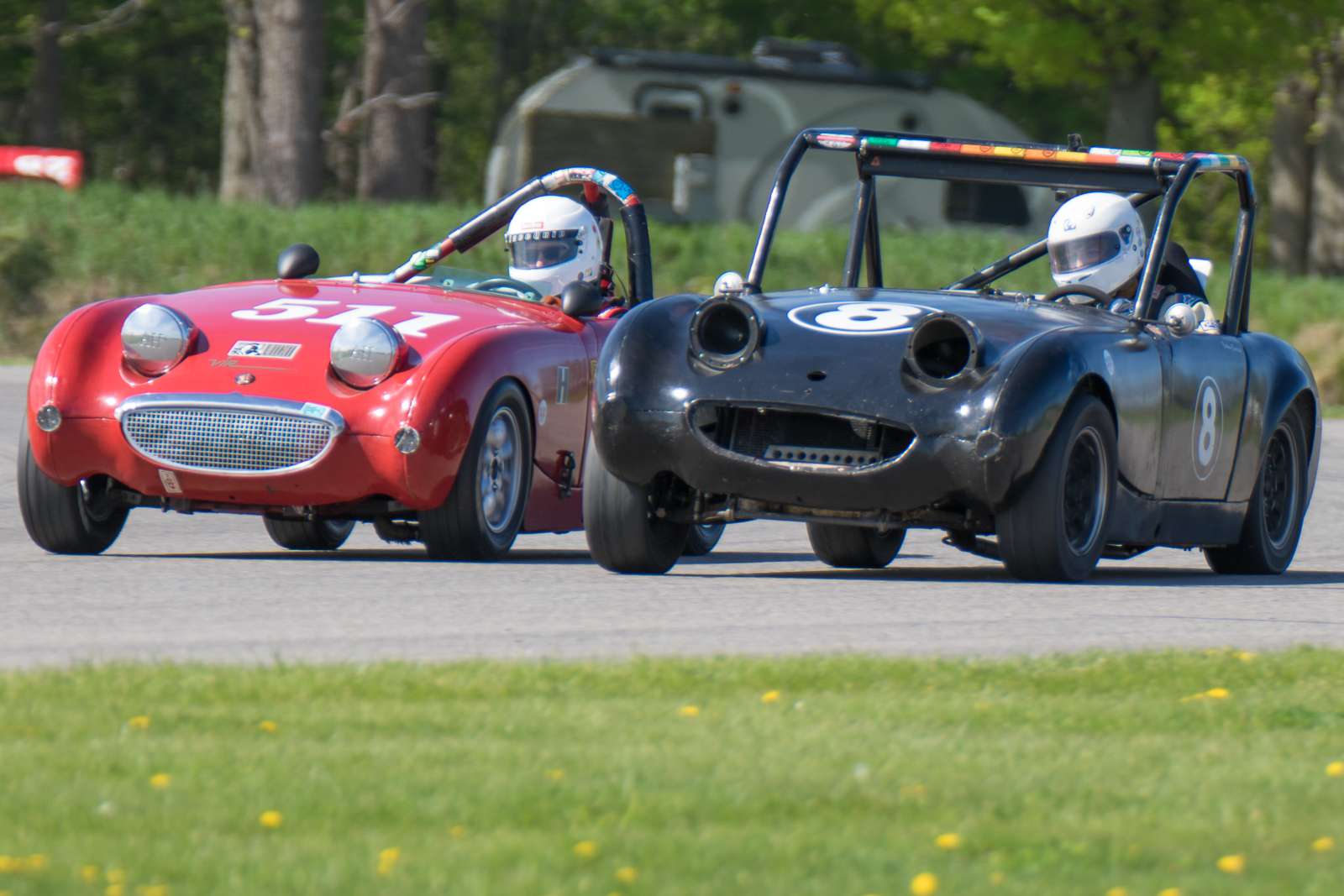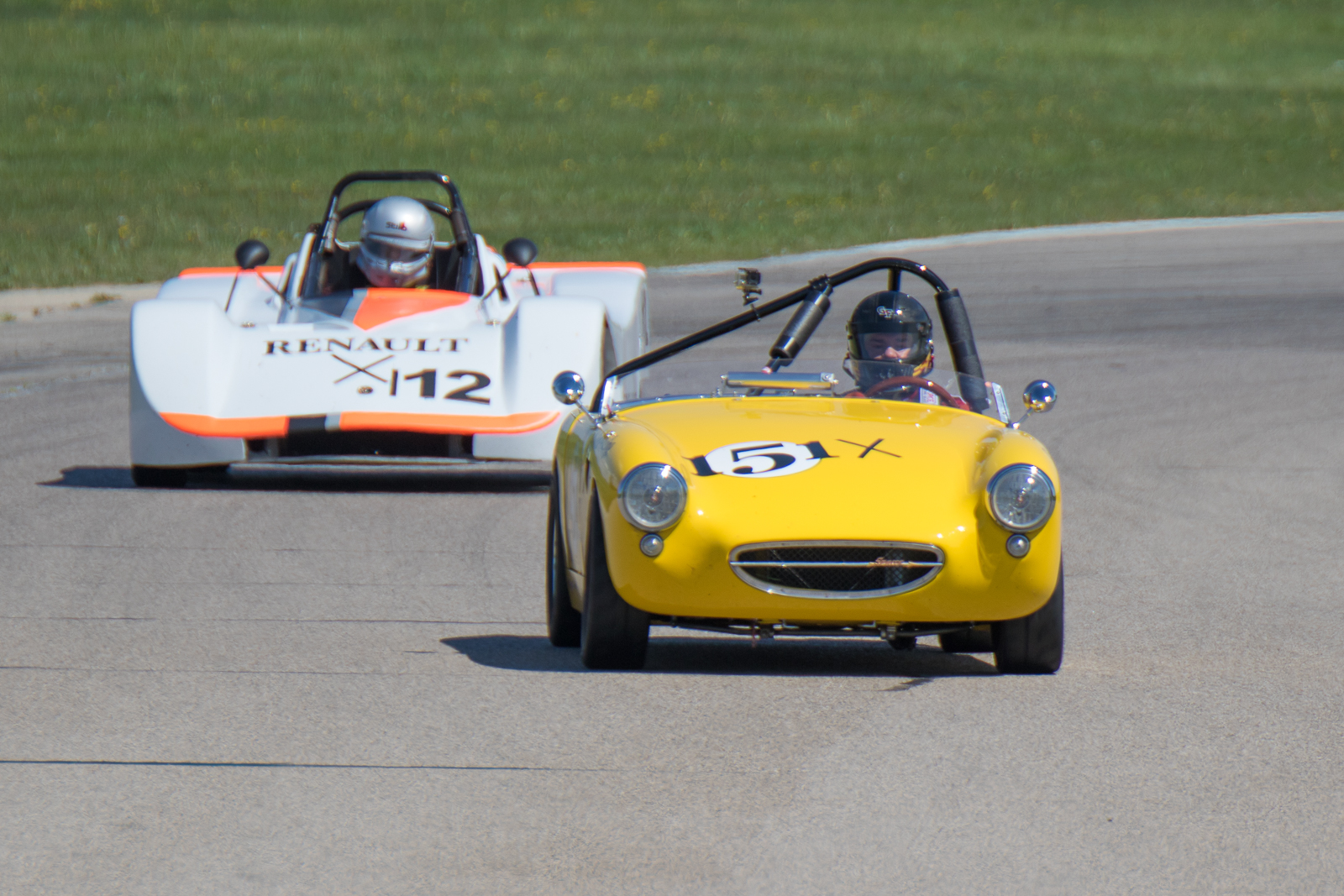2021 VSCDA Spring Brake

A drive through Western Michigan in the spring is good for the soul. Highway 43 runs past orchards and vineyards greening up nicely. Past white farmhouses with green pines and redbuds adding a splash of magenta. Past the junkyard with the brand new C8 vette out front as a brightly-colored non-sequitur. Past the little diner where the rescue crew is grabbing breakfast. Through Bangor, hang a right outside town, a few more miles north, and just like that, I’ve arrived at Gingerman, and the 2021 racing season is underway.
Saturday began with warm-up sessions under sunny skies, but by the time warm-ups were complete, cloud cover had moved over the track and the wind turned blustery and swirling as it worked hard to overtake spridgets on the back straight. The clouds would come and go in bands most of the day on Saturday with brisk breezes throughout.
By mid-morning, we were ready to begin timed practices, kicked off by the Formula Vees known this weekend as Race Group “E”. Eric Coppock in his white ‘69 Lynx and Mitchell Beiser in an orange ‘69 Lynx led the group with fast times in the 1:51’s and Steve Lockwood snuck into the 1:52’s. The nineteen-car group was split about even with half faster than the 2:00 mark.
As always, the Spring Brake race for VSCDA immediately follows their well-known and well-loved drivers school, so we saw lots of “X”’s on cars to indicate recent grads. Gingerman features lots of runoff room, making it well-suited for new drivers, and it’s compact enough that spectators can see multiple corners from many vantage points. In some of these early sessions, it wasn’t unusual to see drivers a little out of shape in some of these corners, or to see a puff of smoke puff up over the low hills as well as drivers explored track limits prior to the races proper.
The B/C group practiced next – a slightly larger field of V8 Group B cars and the B-Sedan-type cars of Group C. David Walters led this session in his blue ‘66 Corvette roadster with a best time of 1:43.924, followed by Daniel Parr’s 1:44.309 in a 1969 Camaro Z28. Mike Pranka kept the V8-powered cars honest with a best time of 1:45.453 in his ‘72 Alfa GTV, and most of the rest of the group managed times better than 2:00.
Group D this weekend included open-wheeled Formula Fords, Super Vees and the like, as well as closed-wheel S2000-type cars. This was generally a speedy group led in practice by John Boxhorn in a 2000 Carbir CS2, turning a best time of 1:34.286. James Cope was next-quickest in a 1987 Swift DB2 at 1:35.659, and the top half of the group was quicker than 1:45, promising some close racing ahead for this group.
Saturday morning’s practice sessions concluded with Group E – generally small-bore production sports cars like spridgets and Minis. John Salisbury’s green ‘62 Sprite was quickest in this session, banking a 1:47.972. A few seconds back, Alan Kremzar followed in his ‘74 MG/B and a best time of 1:53.178, Always a popular class, we saw 30 cars in this session, with a lot of cars clustered around the 2:00 mark for lap times.
Following lunch and the requisite track touring, drivers strapped on their game faces and those with visor tint choices flipped a coin, as the weather continued to alternate between cloudy (with a few sprinkles) and full sun. Ah, Michigan in the spring! Qualifying sessions ran in the same order as practice, and started on time with Group A. Eric Coppock and his Lynx was on top of the leader board again, improving his time to 1:50.883. Mitchell Beiser followed again, but Beiser wasn’t able to improve on his morning time, clocking a 1:52.045, which barely edged out Mike Kitzmiller’s Lynx at 1:52.108. Seventeen cars were timed in this session, with the first seven beating a 2:00 lap time. Based on qualifying time, Group A looked to have some clear leaders and a very busy mid-field pack.
The V8’s and sedans of race group B/C lined up next, and in this qualifying session, the V8 Group B cars managed to hold down the top spots. Daniel Parr improved to 1:44.116 to set pole time, and although David Walter’s 1:43.686 was quicker than his morning time, it only earned him the outside pole. Jason Pearce was close behind in a 1969 Mustang GT and a time of 1:44.109. Mike Pranka was once again the quickest of the non-V8 Group C cars; his 1:46.923 earned a sixth grid spot for the sprint race later in the afternoon.
Group D took some timed laps next. John Boxhorn’s best time of 1:34.402 was barely off his morning’s best time, he lost pole to Avery Stuckart in a blue Carbir. Stuckart improved dramatically from the morning to take quick time at 1:33.844. Third on the grid went to Fritz Seidel in his 2004 Carbir S2000 with a best time of 1:35.071. This group also promised some great mid-pack racing based on some competitive times in the top ten.
Our last qualifying session finished with John Salisbury on top again, but his fast time of 1:49.322 was just a bit slower than his morning time. Ron Soave drove his ‘68 Austin Healey Sprite to second-best with a time of 1:50.625, and Dylan Wittenaurer slotted in third with a lap of 1:51.607.
Saturday had one more round of events for us – a sprint race for each of the four race groups, led off once again by Group A. Eric Coppock started on pole, and led a small break-away group in the first four laps, but an on-track incident involving a couple of those lead-pack cars red-flagged the session at that point. The race ended under the red flag with Coppock on top, followed by Steve Lockwood, who moved up from fifth in his 1969 Zink C4, and John Kennelly, who advanced one spot to take third in a ‘69 Lynx B.
Cleanup from the Group A race wound up delaying the start of the Group B/C race a bit, but the delay gave me a chance to catch up with long-time VSCDA member and instructor Rick Gurolnick, who was instructing this weeked for an incredible 25th time! Rick walked me through the format of the school and we chatted about some of the ways VSCDA’s school remains unique, including the 1:1 student to teacher mapping. Student and instructor pairs break each hour into 20-minute segments, with track time followed by classroom debriefing time and then car prep and driver recharging time. All-in-all, that’s a lot of valuable track time and well-directed immediate feedback from an instructor who follows their student throughout.
Gurolnick’s approach to driving instruction reminded me a lot of a Ross Bently podcast – I heard some of the same lessons about a relaxed driving posture, attention to basics, and repetition of material so that students could drink from that firehose at their individual paces. Perhaps my biggest takeaway, though, was the incredible family-orientation of this club. Gurolnick spoke of multi-generational racing families — including his daughter Robbie who joined Rick in instructing this weekend. I’ve heard stories like this over and over from VSCDA members – the racing families and lifelong friends on and off the track.
Following our delay, the big-bore cars were gridded and anxious. This heat was more orderly — mostly. The top four positions finished where they lined up — Daniel Parr’s Z28 on top, followed by David Walters in his ‘Vette, and then a pair of Mustangs driven by Jason Pearce and Brian Kennedy. Starting sixth, Mike Prankahad a busy race when an early spin dropped him back to the back of the field and made him earn back his top-10 finish the hard way.
A competitive qualifying session hinted at a close race in Group D, and this group gave us a great show. Pole-sitter Avery Stuckart lost the point to John Boxhorn early, but you could throw a blanket over the top three S2000’s for most of the race. Third-place starter Fritz Seidel climbed into the lead by the mid-point of the race, but the top three stayed locked together for the whole show. We saw safety vehicles again at the end of this event for an incident involving the open-wheeled #371 and #35 cars, but the drivers climbed from theri cars under their own power..
Saturday’s racing action wrapped up later than expected with the Group E sprint race. John Salisbury sat on the pole in his ‘62 Sprite, followed by Ron Soave. There was no drama up front with these two, as they’d stay 1-2 for the event. Behind them, though, Scott Fohrman drove a solid stint to advance from an eighth-place starting spot to take the final podium position in his ‘64 MG/B.
Sunday’s weather began sunny and warmer; still breezy, but the nicer of the two race days, to be sure. Warmup sessions got the morning started, and the V8 Challenge was gridded shortly before 10. Featuring just the V8 cars from the B/C group, the tight seven-car field stayed pretty well-sorted for the 30-minute / 15-lap race. Daniel Parr led from the pole in his Z28 and pulled out a comfortable lead on second-place David Walters in his Vette. Close behind Walters, though, Jason Pearce moved into third and hung on to Walters’ bumper, and with the Vette showing a bit of smoke for much of the race, second place was definitely in play.
Next up was a Sprite-Midget (Spridget) feature, which took us up to an early lunch break. This was a strong eighteen-car field — a pretty good portion of race group E, but much of the race was a two-car breakaway led by pole-sitter John Salisbury’s ‘62 Sprite with Ron Soave’s ‘68 Sprite giving chase. This battle was fun to watch while it lasted – Soave managed to close up to Salisbury when they encountered lap traffic. That battle ceased, though, when Soave retired with mechanical issues, sliding Robert Kansa into second in his 1960 Austin Healey. Duane Otness, also in a ‘60 Sprite, finished third, but this event was all about Salisbury, who put a lap on the rest of the field once Soave retired.
Sunday afternoon kicked off with another 30-minute / 15 lap feature devoted to Alfas – the last of the special features. Most of these were the B-Sedan cars you’d expect, but Seb Coppola’s open-wheel Alfa-powered F3 car sat on pole and looked ready to make a fast getaway. Sure enough, Coppola opened a healthy gap, but Mike Pranka held onto second place and the lead lap for most of the race. Moving way up from eight on the grid, though, Michael Besic eventually got by Pranka to take second and drop Pranka to third.
The remaining race group feature events were also 15-lap / 30-minute races, beginning with the Vintage Vees of race group A. Eric Coppock once again led from pole and built a comfortable buffer behind him. He’d wind up crossing the finish line almost half a lap ahead of John Kennally, who moved up a spot to finish second. Mike Kitzmiller was third, another 20 seconds back, having driven well to move up into that last podium spot.
The last B/C race of the weekend started just under 20 cars, led to the flag by David Walters in his Corvette. Mike Pranka and Brian Kennedy skirmished for second for a few laps, but Pranka would retire before half-distance, leaving second solidly in Kennedy’s hands. Eric Wood was third in a yellow ‘66 Alfa GTV to lead the non-V8 entries.
Race group D had given us some great racing earlier in the weekend, and they managed to have one more show ready for us in the feature. Fritz Seidel and John Boxhorn traded the lead, with Seidel building a 16-second lead at the end. A couple spots back, James Cope in his ‘87 Swift had a nice tussle with Anthony Sottile in his ‘86 Swift until Cope retired just beyond half-distance. Sottile would finish in third, with Avery Stuckart in fourth.
Finally, the sports cars of Group E would wrap up our weekend with a 15-lap feature. Salisbury & Soave qualified 1-2 for this, but didn’t take the green for this last event, which opened up the race a bit. The top three in this last event stayed reasonably tight for this whole race. Scott Fohrman was in control for most of this one in his ‘64 MG/B, but Manley Ford was right in his shadow and grabbed the lead for a bit in his ‘63 Lotus Super 7. Just behind these two, Alan Kremzar was ready if either slipped up, but he never had a chance to get his ‘74 MG/B to the front. Further back, several fun battles deep in the pack kept this final race fun to watch, and the great variety of cars in this group was a great way to wind up the weekend.
By Sunday afternoon, I was tired, sunburned, and absolutely thrilled to have been able to spend my weekend with VSCDA, whose next event will be June 18-20 at Blackhawk. Things are looking up for 2021!










